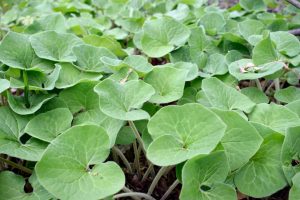Canadian Wild Ginger
 Asarum canadense flowers occupy a very unique location on the plant, having evolved to form at ground level at the base of the stem rather than above the leaves. This characteristic utilizes an interesting method of cross-pollination, for the tubular/bowl-shaped flowers in their convenient location produce a subtle odor that entices beetles and flies to walk inside should they be passing by. The doorway through the dark reddish brown sepals (no petals) is open April through May. Meanwhile, after flower formation, wild ginger slowly unfurls a spreading canopy of 6″ – 8″ heart to kidney-shaped leaves that create a shady canopy overhead. The undersides of the leaves are coated with soft hairs.
Asarum canadense flowers occupy a very unique location on the plant, having evolved to form at ground level at the base of the stem rather than above the leaves. This characteristic utilizes an interesting method of cross-pollination, for the tubular/bowl-shaped flowers in their convenient location produce a subtle odor that entices beetles and flies to walk inside should they be passing by. The doorway through the dark reddish brown sepals (no petals) is open April through May. Meanwhile, after flower formation, wild ginger slowly unfurls a spreading canopy of 6″ – 8″ heart to kidney-shaped leaves that create a shady canopy overhead. The undersides of the leaves are coated with soft hairs.
If no one stops in to visit the flowers when they’re open, as a last resort wild ginger can also self-pollinate. As it matures, both the inner and outer stamens move into an upright position, allowing gravity to assist. Either way, the fruit capsule that forms contains seeds which have a little attachment (called an elaiosome) made up of fats and protein. The nutritious elaiosome entices ants to drag the appendage along with the attached seed (wink wink) back to the nest for a meal — which does not include the seed. The A quicker way of propagation readily occurs for wild ginger annually with the spreading of its rhizomes.
Some things in nature remain hidden until you stumble across their secrets, as I did one day by accident and at the right timing. Previously, each spring I would wonder why there were no flowers emerging from those pretty leaves. Now I know there were no flowers to be seen. All this time, other business was at hand going through its normal cycle under the thick curtain of leaves until those curtains parted, welcoming me at last into a deeper life drama happening in another dimension — another world — revealed below.
